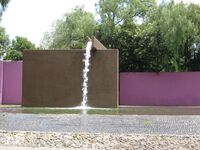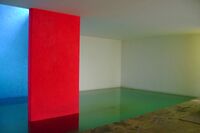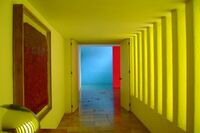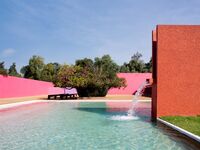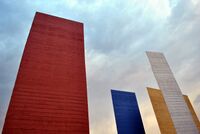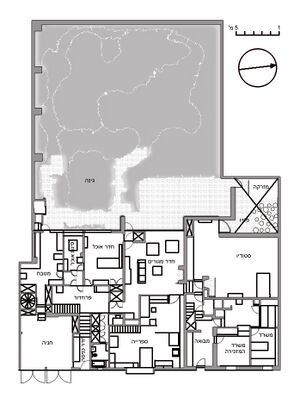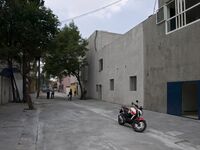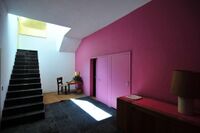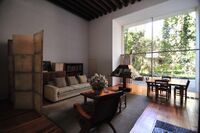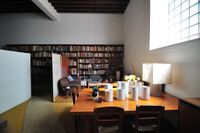لويز برّاگان
Luis Barragán | |
|---|---|
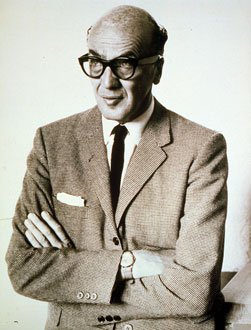 Barragán in 1960s. | |
| وُلِدَ | مارس 9, 1902 |
| توفي | November 22, 1988 (aged 86) Mexico City, Mexico |
| القومية | Mexican |
| المهنة | معماري |
| الجوائز | Pritzker Prize |
| المباني | Torres de Satélite, Casa Gilardi, Barragán House, Jardines de Pedregal Subdivision |
لويز برّاگان (9 مارس 1902 - 22 نوفمبر 1988) بالإنجليزية Luis Barragán Morfin ، هو معماري مكسيكي ويعتبر من أشهر المعماريين في القرن العشرين ، وحائز على جائزة پريتسكر.
السيرة
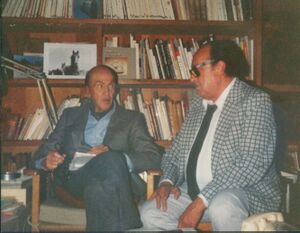
ولد لويز برّاگان عام 1902 وتوفي 1988 ونشأ في المكسيك أتم دراسته وتخصص في الهندسة لكنه علم نفسه مهارات الهندسة المعمارية. وفي الفترة ما بين 1920 الى 1930 تنقل كثيرا ما بين فرنسا و اسبانيا واستكشف اماكن عديدة ولاحقا في عام 1931 استقر لفترة من الوقت في باريس ليحضر محاضرات لي كوربوزيه وفي عام 1951 توسعت رحلاته الى دولة المغرب. رحلاته خلقت لدى المهندسين في المكسيك اهتمام ونوع من الشغف الخاص بهندسة وعمارة شمال افريقيا والأبيض المتوسط التي نقلها الى بلاده و عرضها لهم في المنشآت التي بناها هناك. لقبت أعماله بالأعمال الإصلاحية او الميني ماليزت, وكانت المسطحات النقية والخالية- حوائط الجص واللبنه- الأخشاب التمبر- او حتى الماء هي عناصره الانشائية او التركيبية وكلها تتوافق مع الطبيعة. [1]
مهندس الطبيعة
يلقب برّاگان نفسه بمهندس الطبيعة وذكر في احد الصحف "انا اؤمن بأنه واجب على المهندسين ان يصممو الحدائق بحيث تستخدم بقدر استخدام الناس لمنازلهم للرقي بالإحساس بالجمال والذوق واستمالة الناس للفنون الجميلة والقيم الفنية والروحية الأخرى" واردف لاحقا "إن اي عمل في مجال الهندسة لا يعبر عن الصفاء والسكون هو عمل خاطئ".
برّاگان له اقوال كثيرة مشهورة وكثير من الطلاب يستخدمون احد اقواله كقاعدة يسيرون عليها وفي مسيرة التكريم عادة يلقي الفائزون كلمة ونصائح وغيرها ويذكر انه ختم كلمته بقوله " فن التأمل ... من الضروري للمهندس ان يتقن هذا الفن ويتعلم كيف يرى, أقصد ان يرى بلا حدود وبطريقة تكون الرؤيا عنده حرة غير مقيدة بالتحاليل المنطقية".
مشاريع معروفة
Torres de Satélite (in collaboration with sculptor Mathias Goeritz)
برّاگان وتيار الحداثة
Barragán visited Le Corbusier and became influenced by European modernism. The buildings he produced in the years after his return to Mexico show the typical clean lines of the Modernist movement. Nonetheless, according to Andrés Casillas (who worked with Barragán), he eventually became entirely convinced that the house should not be "a machine for living." Opposed to functionalism, Barragán strove for an "emotional architecture" claiming that "any work of architecture which does not express serenity is a mistake." Barragán used raw materials such as stone or wood. He combined them with an original and dramatic use of light, both natural and artificial; his preference for hidden light sources gives his interiors a particularly subtle and lyrical atmosphere.
التكريم
Barragán worked for years with little acknowledgement or praise until 1975 when he was honored with a retrospective at the Museum of Modern Art in New York City. In 1980, he became the second winner of the Pritzker Architecture Prize. His house and studio, built in 1948 in Mexico City, were listed as a UNESCO World Heritage site in 2004.
التأثير

The work of Luis Barragán is often (and misleadingly) quoted in reference to minimalist architecture. John Pawson, in his book Minimum, includes images from some of Barragán's projects. Most architects who do minimalistic architecture do not use color, but the ideas of forms and spaces which Barragán pioneered are still there.[بحاجة لمصدر] There have been several essays written by the Pritzker Prize recipient Alvaro Siza in prefaces to books that make reference to the ideas of Barragán.[بحاجة لمصدر]
Louis Kahn informally consulted Barragán on the space between the buildings of the Salk Institute in La Jolla, California.[2] According to the documents, Kahn's original idea was to place a garden between the buildings; however, Barragán suggested that an open plaza, with only a water feature in between, would better reflect the spirit of the location. This area, possibly designed with Barragán's advice in mind, is arguably the most impressive aspect of the building complex. He was a highly recognized consultor by many Mexican and International architects on landscape design, as he had a particular ability to envision the outdoor spaces and their relation to their interior paradigms and the natural context characteristics.
Barragán's influence can be seen in the work of many of Mexico's contemporary architects, especially in Ricardo Legorreta's projects. One of the projects, where Barragán's concepts and colors inspired Legorreta, is the Hotel Camino Real in Polanco, Mexico City. This project reflects the importance of the native culture and its intersection with an elegant modern design.
الذكرى
Barragán died at the age of eighty-six in Mexico City. In his will, he designated three people to manage his legacy: Ignacio Díaz Morales, Óscar Ignacio González, and Raúl Ferrera.[3] Ignacio Díaz Morales, a friend and fellow architect, was bequeathed Barragán's library. He was tasked with choosing an institution suitable for receiving the book collection. Óscar Ignacio González, a childhood friend, received Barragán's personal objects. Raúl Ferrera, his business partner, received the archives and the copyright to the work. Díaz Morales established the Fundación de Arquitectura Tapatía, a private foundation managed by the Casa Barragán, in co-ownership with the Government of the State of Jalisco. The house is now a museum which celebrates Barragán and serves as a conduit between scholars and architects interested in visiting other Barragán buildings in Mexico.[4] UNESCO added the Casa Luis Barragán to its World Heritage List in 2004.[5]
Following Raúl Ferrera's passing away in 1993, the archives and related copyright became the property of Mr. Ferrera's widow who, after having unsuccessfully tried to find a collector or institution willing to keep these in Mexico, decided to sell them to the Max Protetch Gallery in New York. The documents were offered to a number of prospective clients, among them the Vitra Design Museum,[6] which in 1994 was planning an exhibition dedicated to Luis Barragán. Following the Vitra[7] company's policy of collecting objects and archives of design and architecture, the archives were finally acquired in their entirety and transferred to the Barragán Foundation in Switzerland.
The Barragan Foundation[8] is a not-for-profit institution based in Birsfelden, Switzerland. Since 1996, it manages the archives of Luis Barragán, and in 1997 acquired the negatives of the photographer Armando Salas Portugal documenting Barragán's work. The Foundation's mission is to spread the knowledge on Luis Barragán's cultural legacy by means of preserving and studying his archives and related historical sources, producing publications and exhibitions, providing expertise and assistance to further institutions and scholarly researches. The Barragán Foundation owns complete rights to the work of Luis Barragán and to the related photos by Armando Salas Portugal.
أعمال هامة
- منزل المهندس المعماري/ منزل برّاگان, مدينة المكسيك (1947-48)
- Jardines del Pedregal تقسيم, مدينة المكسيك(1945-53)
- Tlalpan Chapel, Tlalpan, مدينة المكسيك (1954-60)
- Gálvez House, مدينة المكسيك (1955)
- Jardines del Bosque Subdivision, Guadalajara (1955-58)
- Torres de Satélite, مدينة المكسيك (1957-58), بالتعاون مع Mathias Goeritz
- Cuadra San Cristóbal, Los Clubes, مدينة المكسيك (1966-68)
- Gilardi House, مدينة المكسيك (1975-77)
في الثقافة الشعبية
In Tite Kubo's manga series Bleach, the character Baraggan Louisenbarn is named after Luis Barragán.
وصلات خارجية
- Barragan Foundation - The Archives of Luis Barragán
- Luis Barragan's house and studio (Spanish)
- Barragán's Pritzker Prize citation
المصادر
- ^ ملتقى المهندسين العرب
- ^ "Salk Institute by Louis I. Kahn". Archived from the original on September 1, 2000. Retrieved 2013-08-17.
{{cite web}}: CS1 maint: bot: original URL status unknown (link) - ^ Morales-Casas, Gabriella (2017-06-01). https://www.pressreader.com/mexico/caras-m%C3%A9xico/20170601/281797103941533. Retrieved 2018-10-09 – via PressReader.
{{cite web}}: Missing or empty|title=(help) - ^ Casa Luis Barragán website Archived 2010-09-24 at the Wayback Machine
- ^ List of Mexican Properties on the World Heritage List
- ^ Vitra Design Museum
- ^ Vitra
- ^ Barragan Foundation
[[تصنيف:|براگان]]
- CS1 maint: bot: original URL status unknown
- CS1 errors: missing title
- CS1 errors: bare URL
- Short description is different from Wikidata
- Articles with hatnote templates targeting a nonexistent page
- Articles with unsourced statements from September 2018
- Modernist architects from Mexico
- Architecture firms of Mexico
- Pritzker Architecture Prize winners
- معماريون مكسيكيون
- مواليد 1902
- وفيات 1988
- Architects from Mexico City
- Artists from Guadalajara, Jalisco
- Modernist architecture in Mexico
- 20th-century Mexican architects

